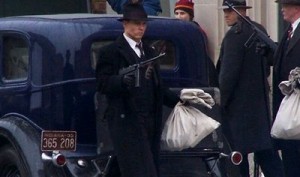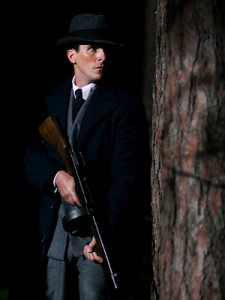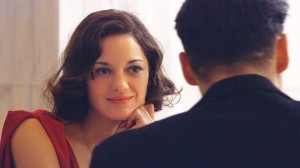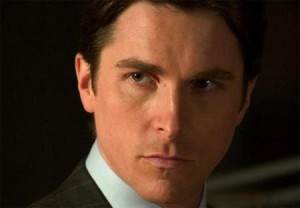Public Enemies
 It’s quite the bold move to deliberately make your movie an eyesore. This is especially true when you’re someone like Michael Mann (Heat, Manhunter, Collateral), who is known specifically for his unique visuals. His new film, Public Enemies, is shot on video, and not in the same way that a lot of new movies are shot on video where they try to replicate film (such as Knowing). But rather, this is an ugly, smeary- looking movie. Mann’s choice is so audacious because he hired Johnny Depp to play the lead, as the real life 1930s bank robber and public icon, John Dillinger, and had him do it in smirking glamour mode (as opposed to method actor mode).
It’s quite the bold move to deliberately make your movie an eyesore. This is especially true when you’re someone like Michael Mann (Heat, Manhunter, Collateral), who is known specifically for his unique visuals. His new film, Public Enemies, is shot on video, and not in the same way that a lot of new movies are shot on video where they try to replicate film (such as Knowing). But rather, this is an ugly, smeary- looking movie. Mann’s choice is so audacious because he hired Johnny Depp to play the lead, as the real life 1930s bank robber and public icon, John Dillinger, and had him do it in smirking glamour mode (as opposed to method actor mode).
Making a movie that looks like it was shot in the producer’s backyard, in your period hat, Tommy gun, and flashing your playboy grin, risks the appearance of a couple of untalented kids finding the backdoor open at the local joke shop who then scavenged the props section. But considering most movies about crime taking place in The Great Depression are sterile, clean, and expensive-looking, Public Enemies’ realistic approach — where people sweat, don’t have sharp clothing or nice apartments, and certainly can’t afford a good dentist — is at least aesthetically pleasing.
 Compared to Michael Mann’s Heat*, Public Enemies is suitably messy and unorganized, especially in the planning of the crimes. De Niro and his crew notoriously meticulously studied every nook and cranny of a bank they intended to steal from. But here, Depp and his rotating band of thieves (including a very amusing Stephen Graham as “Baby Face” Nelson, the movie dovetails without his over-the-top presence in a scene) are reckless and seemingly have no “out” nor plan of escape in case there’s a snag, or even if it goes well. The best of these sequences is a result of the least thought-through robbery, an extraordinary shoot-out with Christian Bale and his honorable and generally overmatched police underlings at a supposed safe-house that continues into the woods and beyond. Just as in the botched robbery in Heat, the realism of the sounds of the gunfire and sequence of events is completely mesmerizing. If anything, Mann is a master of logistics and spatial distance.
Compared to Michael Mann’s Heat*, Public Enemies is suitably messy and unorganized, especially in the planning of the crimes. De Niro and his crew notoriously meticulously studied every nook and cranny of a bank they intended to steal from. But here, Depp and his rotating band of thieves (including a very amusing Stephen Graham as “Baby Face” Nelson, the movie dovetails without his over-the-top presence in a scene) are reckless and seemingly have no “out” nor plan of escape in case there’s a snag, or even if it goes well. The best of these sequences is a result of the least thought-through robbery, an extraordinary shoot-out with Christian Bale and his honorable and generally overmatched police underlings at a supposed safe-house that continues into the woods and beyond. Just as in the botched robbery in Heat, the realism of the sounds of the gunfire and sequence of events is completely mesmerizing. If anything, Mann is a master of logistics and spatial distance.
And yet, despite Mann’s skills coming to the forefront quite frequently, the lack of visual continuity is an enormous detriment in establishing rhythm. It isn’t just that the criminals are often stupid (if you were trying to avoid being shot in the back from quite a distance while running through a field of fruit trees, would you run in a straight line?) and the police loyal and boring (Only Steven Lang, with his hardened, worn face, comes across as more than a cipher). But the only in-between is Depp’s Dillinger, who thinks he’s a public hero for stealing only from the government (“I can choose one bank, they have to be at every bank”) — even if he has to kill people along the way.
Billy Crudup has a few moments as an ambitious and soon-to-be head of the FBI, J. Edgar Hoover. But he’s not in the movie much. And so we mostly get Dillinger’s muddled mindset.
 We’re supposed to find Depp’s sweeping-off-her-feet of coat check girl Marion Cotillard (playing Billie Frechette) charming and romantic. But he mostly drags her to places she doesn’t want to be, while wearing a Monty Python-esque mustache as a disguise. Of course when he’s caught (this isn’t a spoiler, it happens numerous times), she pines for him, even if it appears he didn’t provide her with much. The whole risk-and-reward issue isn’t just confusing on her part, but Dillinger’s as well; because while the supposed bounties are sufficient, especially for 1930s standards, it is never clear where any of the money goes and what causes the need for quick for cash in certain scenes. There’s some minor sketching-in about the criminal world no longer taking Dillinger in as one of its own. But that wouldn’t mean that he’d be broke in what appears to be a few weeks.
We’re supposed to find Depp’s sweeping-off-her-feet of coat check girl Marion Cotillard (playing Billie Frechette) charming and romantic. But he mostly drags her to places she doesn’t want to be, while wearing a Monty Python-esque mustache as a disguise. Of course when he’s caught (this isn’t a spoiler, it happens numerous times), she pines for him, even if it appears he didn’t provide her with much. The whole risk-and-reward issue isn’t just confusing on her part, but Dillinger’s as well; because while the supposed bounties are sufficient, especially for 1930s standards, it is never clear where any of the money goes and what causes the need for quick for cash in certain scenes. There’s some minor sketching-in about the criminal world no longer taking Dillinger in as one of its own. But that wouldn’t mean that he’d be broke in what appears to be a few weeks.
The unflattering visuals also muddy the reasoning for why Dillinger is so interested in Billie Frechette, because the video quality does the normally gorgeous Cotillard no favors. She looks fine in still shots or when she isn’t moving. But when talking or smiling, she looks like Asia Argento’s ugly stepsister, complete with brown, gapped teeth and muppet-goggle eyes.
It’s interesting to think that while Mann’s choice to shoot in a rather pedestrian manner** was the correct one (there’s even a few shots that change focus like consumer cameras that are trying to find what you might want to look at), it actually undermines his movie. Because most of the huge number of characters go by in a literal blur, making no impact. It makes what is a rather expansive story quite a mess of unresolved tangents (especially with Bale’s character, who has one revealing character moment, and it’s during the closing credits). This may have led to Mann’s decision to make Public Enemies more of a macabre comedy of sloppy behavior (a witness to “Baby Face” Nelson’s violent outbursts is asked, “Was he jolly?”).
 Really, Mann should be congratulated, because after the enormous financial failure of his last movie Miami Vice, he somehow convinced his backers to put up $100 million to make a period piece with two of the biggest stars in the world (Bale and Depp) and have it be long, unfocused, and hideous to look at. Perhaps he should push his luck and offer them some prime swampland at a discount price?
Really, Mann should be congratulated, because after the enormous financial failure of his last movie Miami Vice, he somehow convinced his backers to put up $100 million to make a period piece with two of the biggest stars in the world (Bale and Depp) and have it be long, unfocused, and hideous to look at. Perhaps he should push his luck and offer them some prime swampland at a discount price?
*Which was also well over two hours, had a huge cast with a slew of famous names in small parts (though this time they mostly serve as exposition, as opposed to providing flavor) and similarly dealt with cops and [bank] robbers inevitably leading to the violent climax, Al Pacino vs. Robert De Niro in Heat, Christian Bale vs. Depp here.
** If Lars Von Trier had made Public Enemies, the only difference might have been that Depp was robbing banks that were actually chalk outlines.



